Experimental Study of the Load-Transfer Law and Shock Environment of a Pipe–Float System
Abstract
:1. Introduction
2. Experiment
2.1. Objects
2.2. Design
3. Experimental Results and Discussion
3.1. Shock-Wave Load
3.2. Model Performance
3.3. Load-Transfer Law
3.4. Pipe Response
3.5. Shock Environment Evaluation
4. Conclusions
- (1)
- In Case 1, the explosion does not produce an obvious water column but forms a spray that spreads, with the shock-wave load predominantly exhibiting vertical acceleration. In Case 2, the explosion source is shallower and further from the side of the floating shock platform, and the explosion produces an obvious water column. Additionally, the horizontal acceleration component of the shock-wave load is larger than that in Case 1. Overall, the shock-wave load transfer in the pipe–float system decreases from the bottom to the top and from the explosion-facing surface to the back surface. The system structure on the floating raft influences the magnitude of the load acceleration and the composition of the vertical and horizontal components. Moreover, the effect of the system structure on the vertical load transfer is more significant than that on the horizontal load transfer.
- (2)
- The phenomenon of stress concentration is particularly obvious at the bend, with a maximum microstrain value of 3931.7 in Case 1 and 2899.3 in Case 2. The position of the stress concentration is influenced by both the vertical and horizontal components of the acceleration of the shock-wave load. In Case 2, with a larger proportion of horizontal acceleration, the stress concentration in the bend is closer to the inner side of the bend, while in Case 1, the stress concentration in the bend is closer to the bottom of the bend.
- (3)
- The displacement compensation effect of the flexible connector can effectively block the response behavior of the pipes at both ends, resulting in a peak vertical acceleration difference of 98.9%. In Case 1, the maximum vertical and horizontal relative displacements of the two ends of the flexible connector are 12.58 mm and 5.08 mm, respectively.
- (4)
- The shock spectral velocity at A7 and key positions in the pipe–float system are obtained. In Case 1, the vertical spectral velocity and the horizontal spectral velocity are 2.46 m/s and 0.97 m/s, while in Case 2, these values are 0.73 m/s and 1.23 m/s, respectively. These results offer valuable insights for guiding the selection of equipment at key positions on the pipe.
Author Contributions
Funding
Institutional Review Board Statement
Informed Consent Statement
Data Availability Statement
Conflicts of Interest
References
- Yu, Z.L.; Xue, P.; Chen, Z. Nested tube system applicable to protective structures against blast shock. Int. J. Shock. Eng. 2017, 102, 129–139. [Google Scholar]
- Guo, J.; Zhao, X.; Zhang, Y.; Ji, C.; Taranukha, N.A. A simplified boundary condition method for conducting shock resistance analyses of ship piping systems. Int. J. Press. Vessel. Pip. 2020, 180, 104041. [Google Scholar] [CrossRef]
- Alshahrani, R.F.; Merah, N.; Khan, S.M.A.; Al-Nassar, Y. On the shock-induced damage in glass fiber reinforced epoxy pipes. Int. J. Shock Eng. 2016, 97, 57–65. [Google Scholar]
- Okeil, A.M.; Tung, C.C. Effects of ductility on seismic response of piping systems and their implication on design and qualification. Nucl. Eng. Des. 1996, 166, 69–83. [Google Scholar] [CrossRef]
- Zhu, L.; Liu, Q.Y.; Jones, N.; Chen, M.S. Experimental study on the deformation of fully clamped pipes under horizontal shock. Int. J. Shock. Eng. 2018, 111, 94–105. [Google Scholar]
- Wang, Y.; Qian, X.D.; Liew, J.Y.R.; Zhang, M.H. Experimental behavior of cement filled pipe-in-pipe composite structures under transverse shock. Int. J. Shock Eng. 2014, 72, 1–16. [Google Scholar]
- Kristoffersen, M.; Casadei, F.; Børvik, T.; Langseth, M.; Hopperstad, O.S. Shock against empty and water-filled X65 steel pipes—Experiments and simulations. Int. J. Shock Eng. 2014, 71, 73–88. [Google Scholar]
- Semke, W.H.; Bibel, G.D.; Jerath, S.; Gurav, S.B.; Webster, A.L. Efficient dynamic structural response modelling of bolted flange piping systems. Int. J. Press. Vessel. Pip. 2006, 83, 767–776. [Google Scholar] [CrossRef]
- Wang, H.L.; Ding, H. Vibration reduction of floating raft system based on nonlinear energy sinks. Ocean. Eng. 2023, 288, 116211. [Google Scholar] [CrossRef]
- Qu, Y.D.; Wu, J.D.; Xu, B.Y.; Li, Q.Y. Evaluating the shape and orientation effect of non-spherical charge on the pressure distribution of underwater explosion: Finite element analysis. Ocean. Eng. 2022, 266, 113209. [Google Scholar] [CrossRef]
- Wang, P.R.; Shi, D.Y.; Cui, X.W.; Ma, C.L.; Su, B.; Li, G.L. Study on bubble pulsation process of underwater explosion between parallel plates with various distances. Ocean. Eng. 2023, 278, 114512. [Google Scholar] [CrossRef]
- Ma, T.; Wang, J.X.; Liu, L.T.; Li, H.; Tang, K.; Lin, S.J.; Gu, Y.C. Study on directional enhancement effect of underwater explosion for cylindrical explosive with large length-to-diameter ratio and structural response of nearby water-back plate. Ocean. Eng. 2022, 266, 112614. [Google Scholar] [CrossRef]
- Gannon, L. Simulation of underwater explosions in close-proximity to a submerged cylinder and a free-surface or rigid boundary. J. Fluids Struct. 2019, 87, 189–205. [Google Scholar] [CrossRef]
- Zhang, Z.H.; Wang, Y.X.; Zhao, H.F.; Qian, H.F.; Mou, J.L. An experimental study on the dynamic response of a hull girder subjected to near field underwater explosion. Mar. Struct. 2015, 44, 43–60. [Google Scholar] [CrossRef]
- Wang, G.H.; Zhang, S.R.; Yu, M.; Li, H.B.; Kong, Y. Investigation of the shock wave propagation characteristics and cavitation effects of underwater explosion near boundaries. Appl. Ocean Res. 2014, 46, 40–53. [Google Scholar] [CrossRef]
- Brett, J.M.; Krelle, A. A study of bubble collapse pressure pulse waves from small scale underwater explosions near the water surface. J. Sound Vib. 2018, 435, 91–103. [Google Scholar] [CrossRef]
- Zhang, A.M.; Zhou, W.X.; Wang, S.P.; Feng, L.H. Dynamic response of the non-contact underwater explosions on naval equipment. Mar. Struct. 2011, 24, 396–411. [Google Scholar]
- Gao, Y.; Wang, S.S.; Zhang, J.X.; Jia, X.Y.; Sheng, Z.X. Influence of water depth on the peak overpressure and energy of the secondary pressure wave of underwater explosions. Ocean. Eng. 2024, 293, 116580. [Google Scholar] [CrossRef]
- GJB1060.1-91; Ship Environmental Conditions Requirements-Mechanical Environment. National Defense Science and Technology Commission: Beijing, China, 1991.
- BV0430/85; Code for Ship Construction-Shock Safety. FRG Ministry of Defense Equipment Technology and Procurement: Koblenz, Germany, 1985.
- Jin, H.; Gao, X.; Xi, H.W. Design and shock environment analysis of medium floating shock platform. Mod. Appl. Phys. 2019, 10, 66–71. [Google Scholar]
- Wang, J.; Yao, X.L.; Yang, D. Shock analysis of shock environment from floating shock platform equipment response. Explos. Shock Waves 2015, 35, 236–242. [Google Scholar]
- Yao, X.L.; Zhao, K.; Shi, D.Y. Study on the effectiveness of shock factor in underwater explosion model test. Int. J. Shock. Eng. 2014, 185, 104839. [Google Scholar]
- Mannacio, F.; Barbato, A.; Marzo, F.D.; Gaiotti, M.; Rizzo, C.M.; Venturini, M. Shock effects of underwater explosion on naval ship foundations: Validation of numerical models by dedicated tests. Ocean. Eng. 2022, 253, 111290. [Google Scholar] [CrossRef]

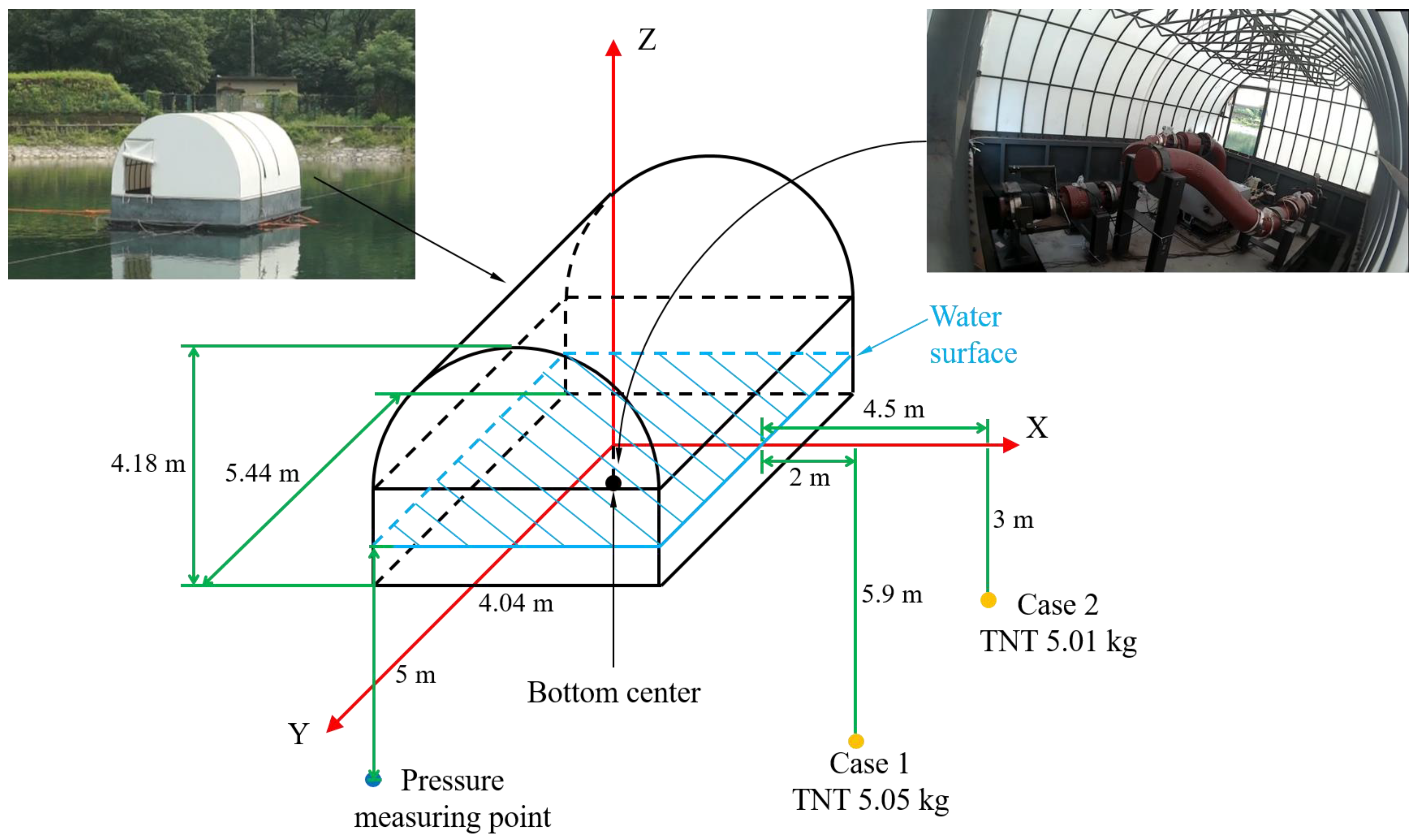




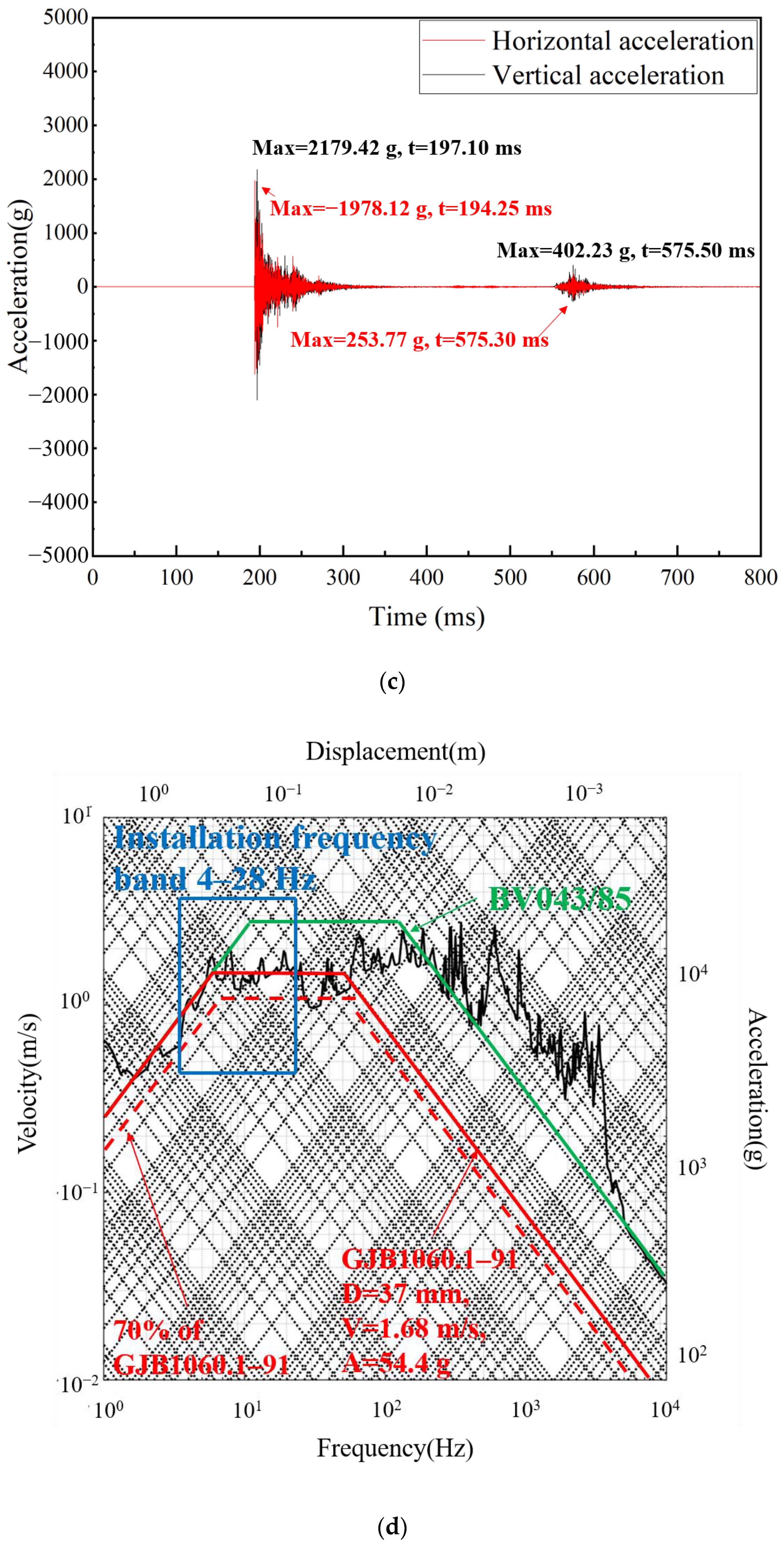
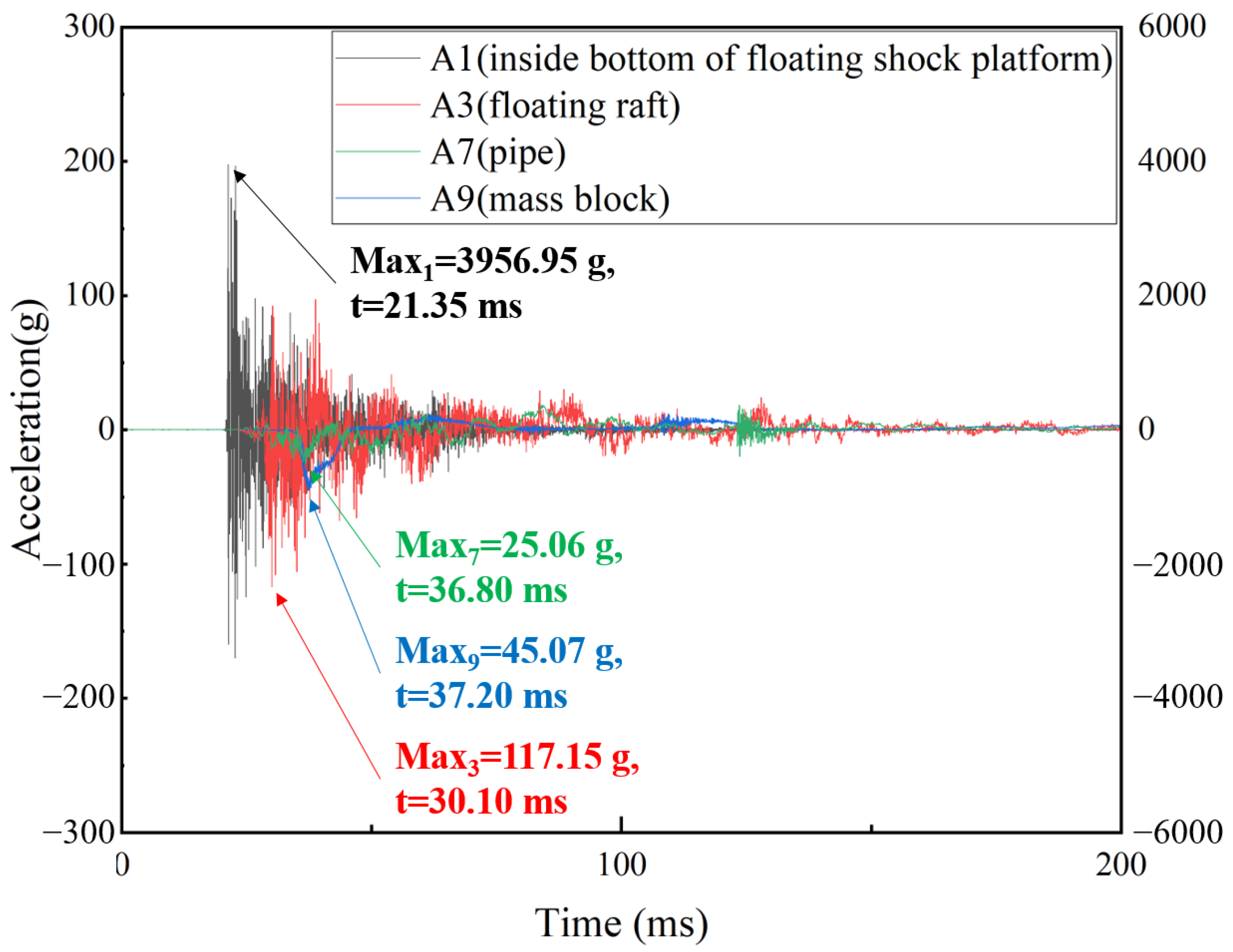

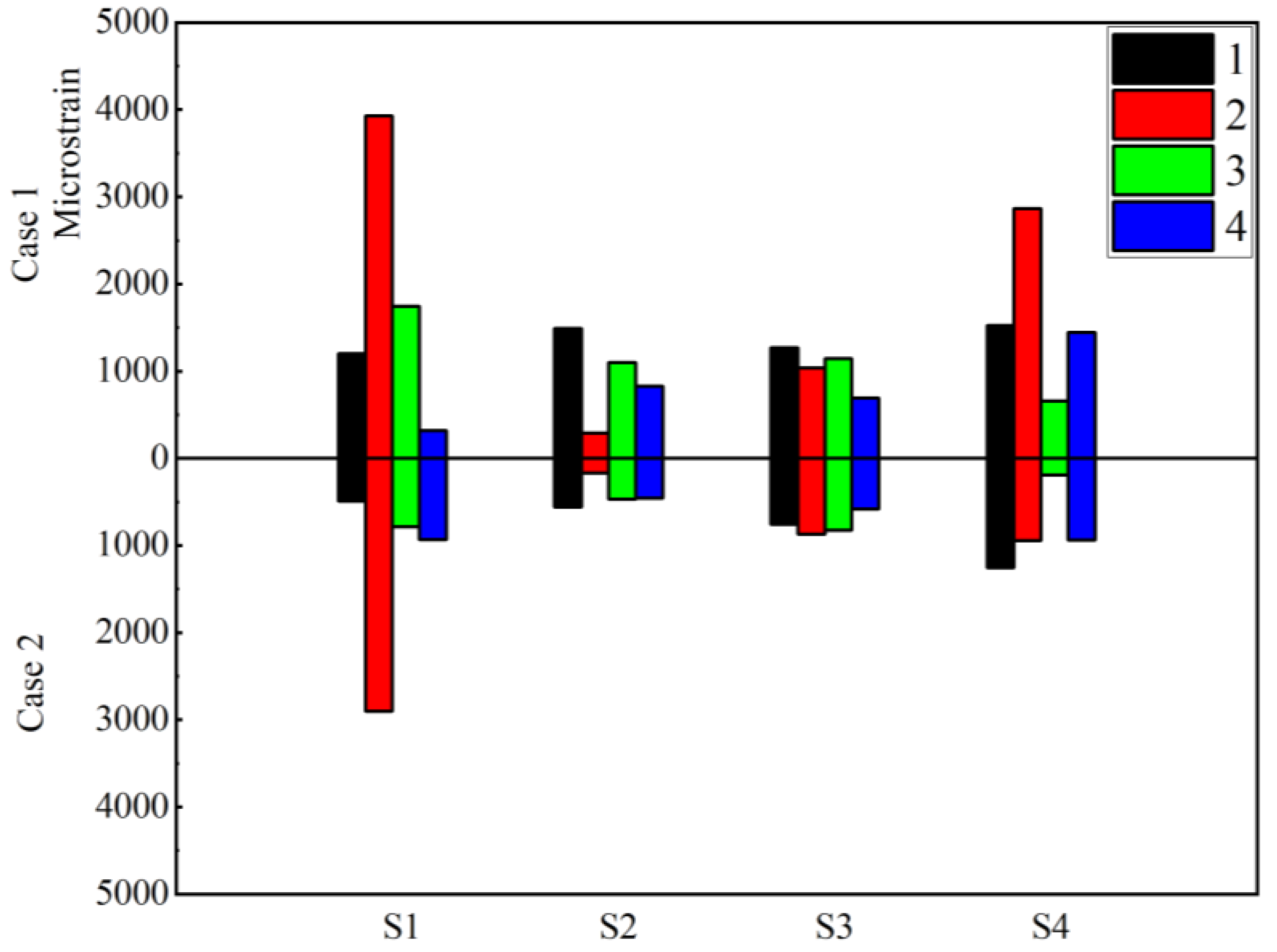
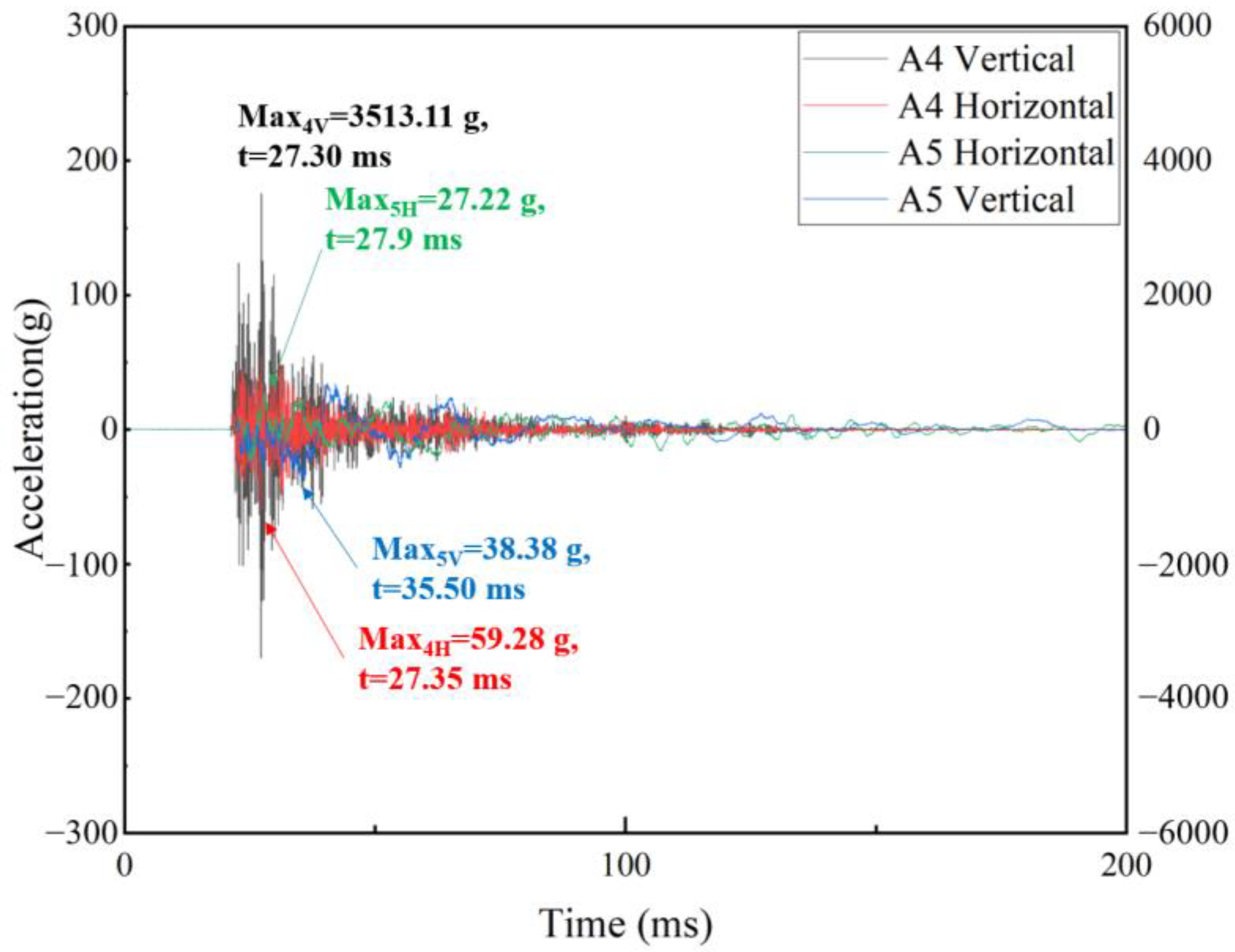
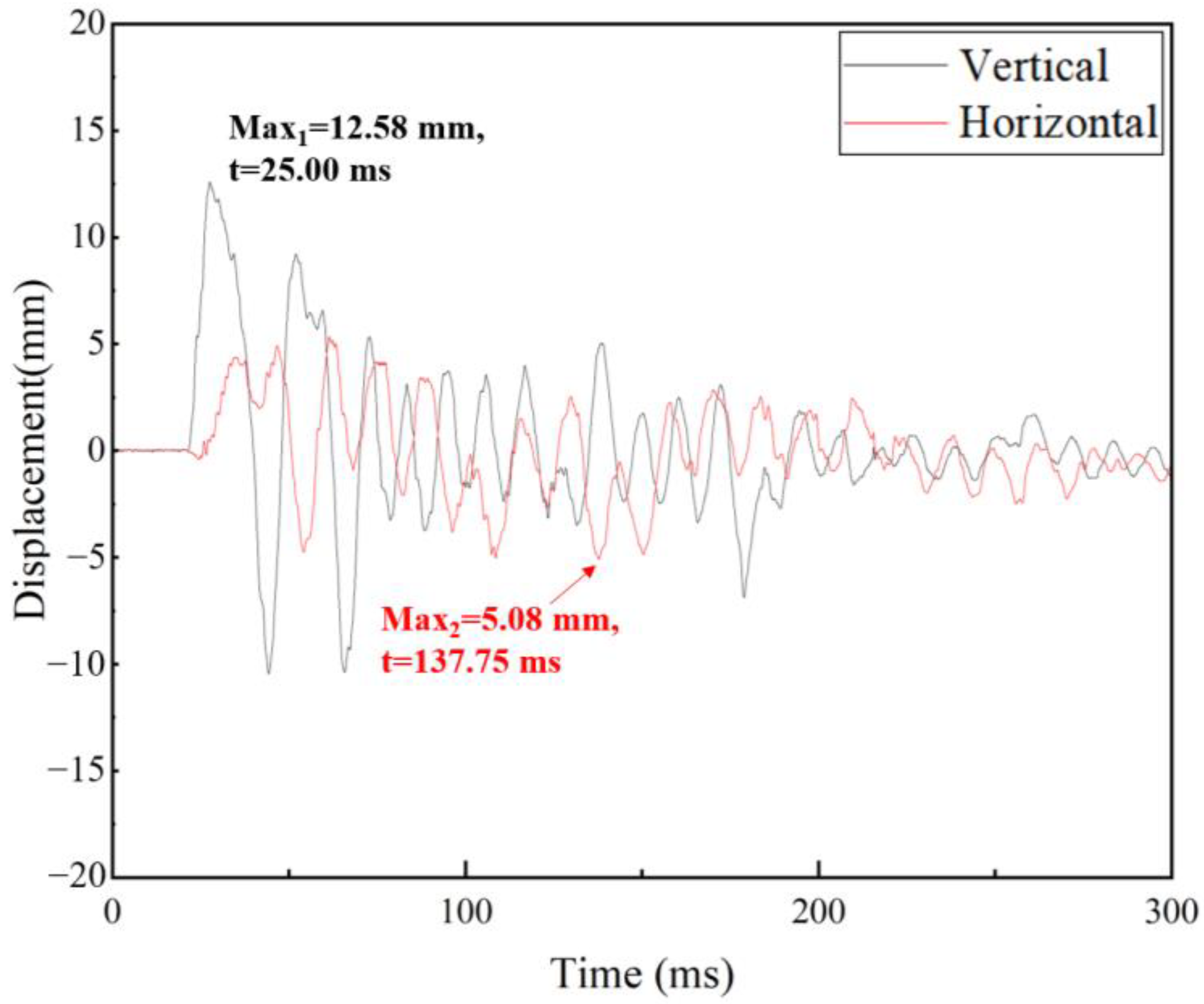
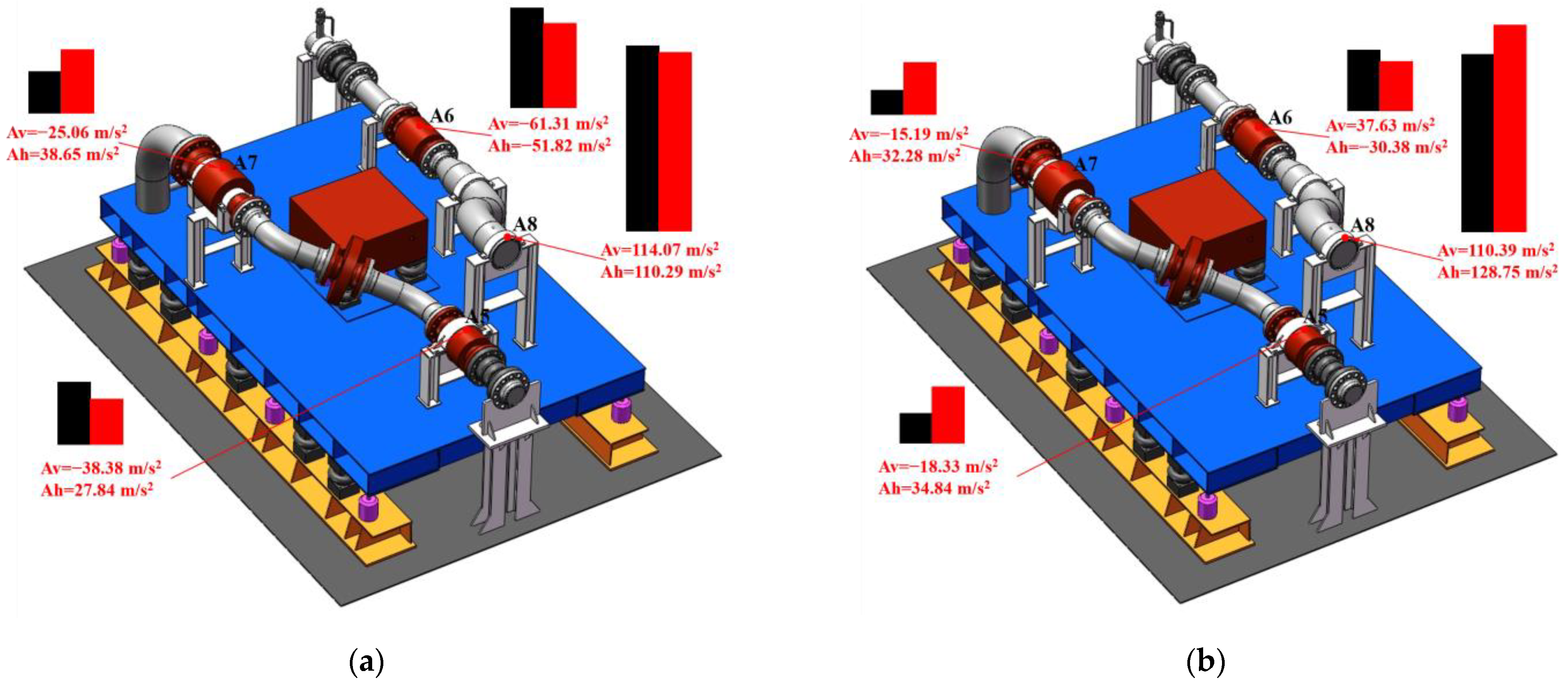
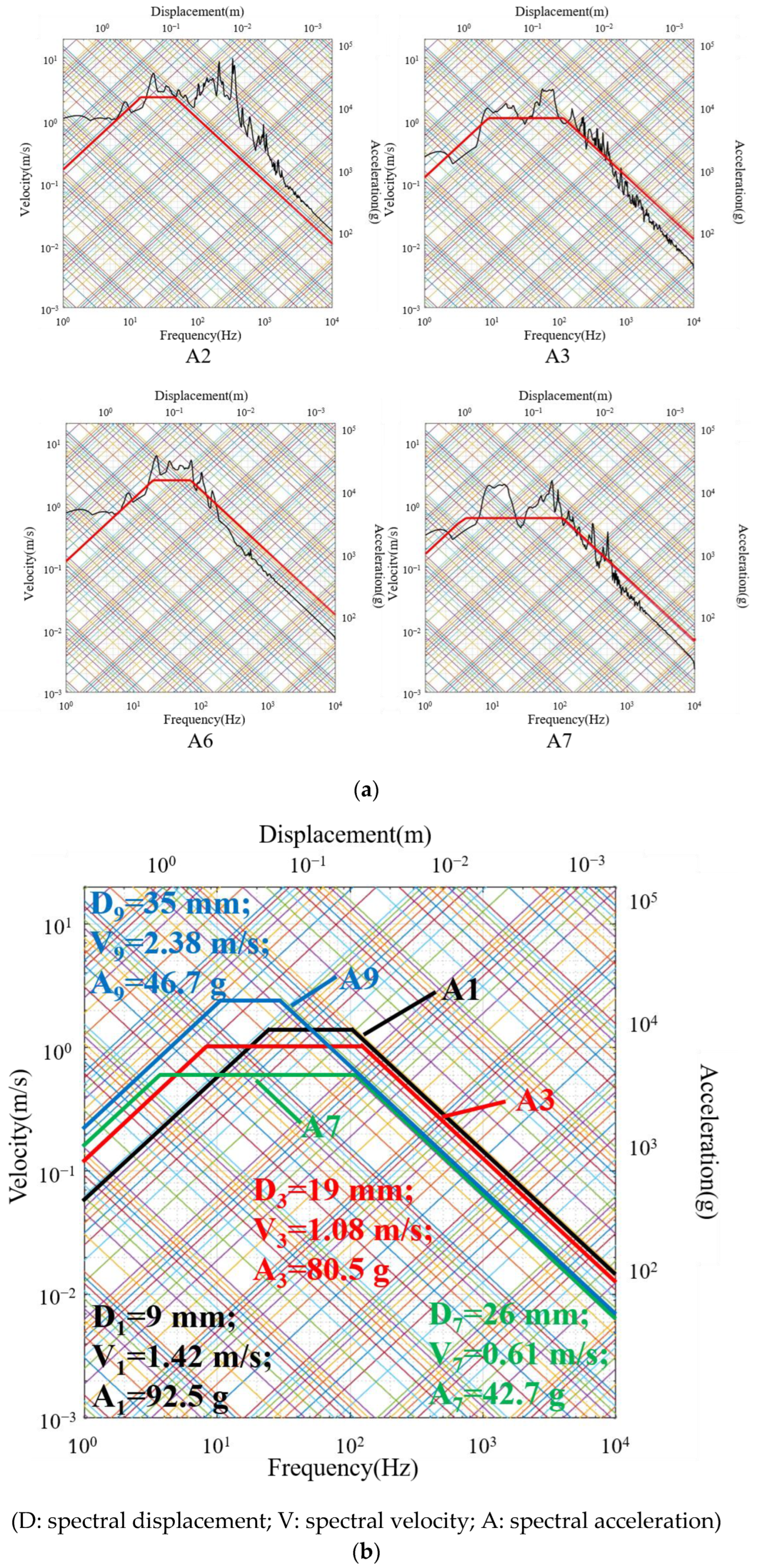

| Item | Parameters | ||||||
|---|---|---|---|---|---|---|---|
| Allowable Displacement (mm) | Maximum Displacement (mm) | ||||||
| Lower displacement restrictor | 8 | 20 | |||||
| Upper displacement restrictor | 4 | 7 | |||||
| Pressure (bar) | 3 | 4 | 5 | 6 | 7 | 8 | |
| Shock absorber | Stiffness (N/mm) | 150 | 205 | 260 | 315 | 370 | 425 |
| Signal Type | Sensor | Amplifiers | Acquisition Instruments | ||||
|---|---|---|---|---|---|---|---|
| Model | Range and Accuracy | Acquisition Frequency (Hz) | Model | Accuracy | Model | Accuracy | |
| Pressure | PCB138M | 5% | 2,000,000 | / | / | GENESYS | 1% |
| Strain | KFGS-5-120-C1-11 LIM2R | 50,000 με 1% | 20,000 | DH3810 | 1% | DH5902 | 1% |
| Acceleration | ENDECVO2270(A1), BK4384(A2-A8) | 10,000 g 5%, 5000 g 5% | 20,000 | DH5902 | 1% | ||
| Displacement | FT80 RLA-220 | 220 mm 2% | 20,000 | / | / | ||
| Case | Peak Shock Pressure | Bubble Pulsation Period | ||||
|---|---|---|---|---|---|---|
| Experimental Value | Theoretical Value | Error | Experimental Value | Theoretical Value | Error | |
| 1 | 12.16 | 11.27 | 7.3% | 344.3 | 361.0 | 4.9% |
| 2 | 9.29 | 7.85 | 15.5% | 362.9 | 425.9 | 17.4% |
Disclaimer/Publisher’s Note: The statements, opinions and data contained in all publications are solely those of the individual author(s) and contributor(s) and not of MDPI and/or the editor(s). MDPI and/or the editor(s) disclaim responsibility for any injury to people or property resulting from any ideas, methods, instructions or products referred to in the content. |
© 2024 by the authors. Licensee MDPI, Basel, Switzerland. This article is an open access article distributed under the terms and conditions of the Creative Commons Attribution (CC BY) license (https://creativecommons.org/licenses/by/4.0/).
Share and Cite
Li, M.; Li, J.; Chen, W.; Lei, Z.; Zhou, L.; Li, M.; Li, C.B.; Li, X. Experimental Study of the Load-Transfer Law and Shock Environment of a Pipe–Float System. J. Mar. Sci. Eng. 2024, 12, 650. https://doi.org/10.3390/jmse12040650
Li M, Li J, Chen W, Lei Z, Zhou L, Li M, Li CB, Li X. Experimental Study of the Load-Transfer Law and Shock Environment of a Pipe–Float System. Journal of Marine Science and Engineering. 2024; 12(4):650. https://doi.org/10.3390/jmse12040650
Chicago/Turabian StyleLi, Miaoran, Jun Li, Wei Chen, Zhiyang Lei, Lijiang Zhou, Mengzhen Li, Chun Bao Li, and Xiaobin Li. 2024. "Experimental Study of the Load-Transfer Law and Shock Environment of a Pipe–Float System" Journal of Marine Science and Engineering 12, no. 4: 650. https://doi.org/10.3390/jmse12040650





